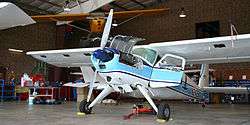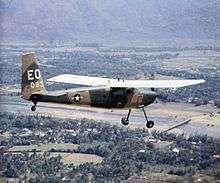Helio Courier
| Helio Courier | |
|---|---|
 | |
| Helio H295 Super Courier of 1967 at Valle, Arizona, in October 2005 | |
| Role | STOL Utility aircraft |
| Manufacturer | Helio Aircraft Company |
| Designer | Otto C. Koppen, Lynn Bollinger[1] |
| First flight | 14 April 1949 |
| Introduction | 1954 |
| Status | some still flying in 2009 |
| Primary user | Military forces and private pilots |
| Number built | 500 (approximate total) |
| Unit cost |
$151,600 in 1984 |
| Variants | Helio Stallion |

The Helio Courier is a cantilever high-wing light C/STOL utility aircraft designed in 1949.
Around 500 of these aircraft were manufactured in Pittsburg, Kansas from 1954 until 1974 by the Helio Aircraft Company. During the early 1980s, new owners (Helio Aircraft Ltd.) made an attempt to build new aircraft with direct-drive Lycoming engines, to replace troublesome and expensive geared engines. In a further effort to reduce weight, a new composite landing gear was featured. The new models also featured modest winglets. Two models were produced, the H-800 and H-700. A total of 18 aircraft were built. The rights to the Helio Stallion and Helio Courier were acquired by Helio Aircraft of Prescott, Arizona, and will soon be returned to production.[2]
Design and development
Otto C. Koppen designed aircraft for the Stout Metal Airplane Division of the Ford Motor Company, including the Ford Flivver, an aircraft that was supposed to be mass-produced by Ford. Koppen went on to design the Helio Courier.[3]
The all aluminum-clad airframe features a welded 15G steel-tube center section fuselage, with shoulder harnesses that protect the occupants in an emergency. The wings are of conventional aluminum construction, but feature Handley Page leading-edge slats that deploy automatically when the aircraft's airspeed falls below a certain value — 55 to 60 miles per hour (89 to 97 km/h). The slats contribute to the Helio's outstanding short takeoff and landing (STOL) capability, and allow for stall/spin-proof controllable flight. In conjunction with the leading-edge slats, 74% of the trailing edge incorporates high-lift slotted flaps, which together with interrupter blades atop each wing when roll control is lost at very low airspeed, allows for a tight turning radius. The Helio Courier could maintain control at speeds as low as 27 miles per hour (43 km/h).[4]
The design of the Helio features a large vertical tail surface and rudder for control at very low flight speeds. However, on conventional geared aircraft (taildraggers), the airplane tends to be sensitive to crosswinds, thus a crosswind gear option is available, allowing the main tires to caster left or right 20 degrees, increasing the crosswind component to 25 miles per hour (40 km/h). The Helio has its main gear placement far forward of the cabin, enabling hard braking on unprepared landing areas. A tricycle-gear model was produced, but is unsuitable for unprepared rough terrain.
Helios are also capable of being equipped with floats; both straight and amphibious floats being offered.
Operational history





With a minimum-control speed of around 28 mph, the Courier is perfectly suited for confined off-airport operations. The first one was certified in July 1954 and powered by the 260 hp Lycoming GO-435-C2B2. The first production Courier (Serial Number 001, dubbed "Ol' Number 1")C-G001 was previously owned and operated by JAARS as N242B until 2010.[5] Jaars Helio Courier has been a frequent airshow performer at EAA AirVenture Oshkosh for decades, displaying its slow flight capability in front of thousands and serving as a drop plane for the Liberty Parachute Team.[6]
In 1957, a "Strato Courier" set an altitude record over Mexico City, Mexico at 31,200 ft powered by a geared Lycoming GSO-480-A1A5 (340 hp), only one was built. The Super Courier, a more powerful derivative, was used by the US Air Force from 1958 onward, by the US Army Special Forces in the 1960s and 1970s and by Air America during the Vietnam War as the U-10. In U.S. Army and Air Force service, the U-10 Super Courier was used for liaison work, light cargo and supply drops, psychological warfare, forward air control (Air Force), insertion and extraction land and sea (Army) and reconnaissance. Various versions were produced up through the 1980s, including turbine-powered variants.
The Super Courier saw military service in the United States as the U-10 (ex L-28). Over 120 were built: The L-28A (2, later redesignated U-10A), U-10A (26), U-10B extended range and paratrooper doors (57), and the U-10D with a higher gross weight(36). There was no U-10C.
Helios remain very popular among bush pilots in Canada (32 current) and Alaska and missionaries who fly into rough, relatively unprepared jungle airstrips because of its superior STOL abilities. Some operators use the Helio Couriers for aerial observation. Both Winged Vision Inc. of Gaithersburg, Maryland and the Pima County, Arizona, Sheriff's Department each operate two of the rare tri-gear model and mount gyro-stabilized cameras under the wing for aerial observation.[7] Pima County mounts a FLIR camera for law enforcement, and Winged Vision mounts a high definition television camera for coverage of major sports events.[8]
Variants
- Koppen-Bollinger Helioplane.[9]
- Original prototype soon re-named Helio Courier.
- Helioplane Four.
- unknown possible variant.
- Helioplane Two.
- unknown possible variant.
- Hi-Vision Courier.
- unknown possible variant.
- H-291.
- Prototype, one built.
- H-295 Super Courier.
- Variant with a Lycoming GO-480-G1D6, purchased by USAF as U-10D, 173 built.
- HT-295 Super Courier or Trigear Courier.
- H-295 with tricycle undercarriage, 19 built.
- H-250 Courier.
- H-295 with lengthened fuselage and Lycoming O-540-A1A5 engine, 41 built.
- H-391 Courier.
- Prototype with Lycoming GO-435-C2 engine, one built.
- H-391B Courier.
Production version of H-391, 102 built.
- H-392 Strato Courier.
- High-altitude version of H-391 with Lycoming GSO-480-A1A5 engine (340 hp).
- H-395 Super Courier.
- H-391B with Lycoming GO-480-G1D6, purchased by USAF as U-10A and U-10B, 138 built.
- H-395A Courier.
- Variant of the H-395 with a Lycoming GO-435-C2B6 engine, seven built.
- H-500 Twin Courier.
- Twin-engined H-395 for the CIA. Very little information available except seven delivered to the CIA under front designation U-5.
- Helio H-550 Stallion.
- Turboprop powered development
- H-580 Twin Courier.
- A longer nosed H-500 with twin wing mounted piston engines, five built.[1]
- H-634 Twin Stallion
- Planned twin Allison C250 powered Stallion.
- H-700 Courier.
- H-295 with redesigned wing and undercarriage and Lycoming TIO-540-J2B engine.
- H-800 Courier.
- H-700 with Lycoming IO-720-A1B engine, 18 built (H-700 and H-800 together).
- L-24 Courier.
- Military version of the H-391 Courier.
- L-28 Courier.
- Military version of the H-395 Courier.
- U-5 Twin Courier.
- Probable front designation for CIA Twin Couriers.
- U-10 Courier
- Re-designation of L-28 Courier
- U-24 Stallion
- Military designation for H-550 Stallion
Operators
Military operators
- Bophuthatswana Air Force – 2 operated from 1982.[10]
- Italian Air Force operated 1 Helio Courier aircraft from 1961 to 1982[11]
- Civil Air Patrol
- United States Air Force
- 4410th Combat Crew Training Squadron
- United States Army
Civil operators
Preserved aircraft
_(27410426832).jpg)
- U-10A Courier, AF Ser. No. 62-3606, (c/n 540) preserved at the Hurlburt Field Memorial Air Park, Hurlburt Field, Florida[12]
- U-10B Courier, AF Ser. No. 63-13096, on display at the Museum of Aviation at Robins AFB, Georgia[13]
- U-10B Courier, 7135 (c/n 576), ex-USAF / AF Ser. No. 66-14332 on display at the Royal Thai Air Force Museum, Bangkok, Thailand.[14]
- U-10D Super Courier, AF Ser. No. 66-14360, on display at the National Museum of the United States Air Force, Wright-Patterson AFB, Ohio[15]
- HT-295 Helio Super Courier (c/n 1711) Fully operational, based in Pietermaritzburg, KwaZulu-Natal, South Africa. (Owner: Josef Martin, Dabmar Manufacturing Company, Hattingspruit, KZN, South Africa)[16]
Specifications (U-10D Super Courier)
Data from [17]
General characteristics
- Crew: one, pilot
- Capacity: 5 passengers
- Length: 30 ft 8 in (9.35 m)
- Wingspan: 39 ft 0 in (11.89 m)
- Height: 8 ft 10 in (2.69 m)
- Useful load: 1,320 lb (600 kg)
- Loaded weight: 3,600 lb (1,636 kg)
- Powerplant: 1 × Lycoming GO-480-G1D6 geared 6-cylinder engine, 295 hp (220 kW)
Performance
- Maximum speed: 148 knots (170 mph, 288 km/h)
- Range: 950 nm (1,380 miles, 1,760 km) with 120 gal. fuel
- Service ceiling: 20,500 ft (6,250 m)
- Rate of climb: 1,200 ft/min (6.1 m/s)
See also
- Related development
- Aircraft of comparable role, configuration and era
- De Havilland Canada DHC-2 Beaver
- Cessna 180
- Cessna 185
- Dornier Do 27
- Maule M-5
- Max Holste Broussard
- Murphy Moose
- Scottish Aviation Pioneer
- Pilatus Porter
References
Notes
- 1 2 Flying, March 1984, p. 54.
- ↑ "Helio Courier." Helio Aircraft. Retrieved: October 3, 2011.
- ↑ Peterson, Norm. "There's a Ford in your Future." Sport Aviation, August 1991.
- ↑ "Small Plane Copies Copter." Popular Science, August 1949, p. 135.
- ↑ "Very First Helio Courier Alive and Well in Canada." EEA, February 13, 2012.
- ↑ Koepenick, Jim. "Antiques and Classics at Oshkosh '91." Sport Aviation, November 1991.
- ↑ Thomas Horne (June 2014). "Eye on Sport". AOPA Pilot: 64.
- ↑ "News & Press Coverage." Helio Aircraft. Retrieved: October 3, 2011.
- ↑ "Leaps Off Lawn." Popular Science, October 1949, pp. 109, 110.
- ↑ Hatch, Paul F. (July 1985). "Air Forces of the World: Bophuthatswana Defence Force Air Wing". Air Pictorial. Vol. 47 no. 7. p. 249.
- ↑ aeroflight
- ↑ Ogden 2007, p. 200.
- ↑ Ogden 2007, p. 225.
- ↑ "Building 1: Aircraft flown by RTAF after WW2." Royal Thai Air Force Museum. Retrieved: January 11, 2011.
- ↑ "Factsheets : Helio U-10D Super Courier". Nationalmuseum.af.mil. 2011-02-15. Retrieved 2013-11-28.
- ↑ "HT-295 Helio Super Courier." airliners.net. Retrieved: October 3, 2011.
- ↑ "Helio Courier: Performance & Specifications." Helio Aircraft. Retrieved: October 3, 2011.
Bibliography
- Ogden, Bob. Aviation Museums and Collections of North America. Tonbridge, Kent, UK: Air-Britain (Historians) Ltd, 2007. ISBN 0-85130-385-4.
- Simpson, R. W. Airlife's General Aviation. Shrewsbury, UK: Airlife Publishing, 1995, pp. 208–210. ISBN 1-85310-577-5.
- Taylor, Michael J. H. Jane's Encyclopedia of Aviation. London: Studio Editions, 1989. ISBN 0-517-69186-8.
- World Aircraft Information Files. London: Bright Star Publishing, File 896, sheet 18.
External links
| Wikimedia Commons has media related to Helio Courier. |
- Helio Aircraft homepage
- USAF Museum
- Modern aerial photography Courier operator
- HelioCourier.Net
- "Rugged Light Plane Takes to the Air After 30-yard Run." Popular Mechanics, November 1954, p. 144.